The Third Sector's Contribution to Public Service: An Evaluation
VerifiedAdded on 2023/01/10
|10
|2990
|41
Report
AI Summary
This report provides a comprehensive overview of the third sector's involvement in public service delivery, focusing on the context of the Covid-19 emergency. It begins by defining the third sector and outlining key historical events that have shaped its role, such as the Beveridge Report and the Big Society initiative. The report then identifies the various types of work third sector organizations undertake, including community and voluntary work, and charitable activities. It also details the types of public services delivered, such as public campaigning, advocacy, and commissioning research. Furthermore, the report defines examples of third sector organizations like Age UK, Oxfam, and Barnardo's delivering public services. Finally, it explores the ways in which these organizations partner with public services, highlighting benefits and barriers to these collaborations, such as property transfers, funding for capacity building, and communal support. The report concludes by emphasizing the significance of the third sector in supporting public services and the importance of these partnerships for effective public welfare.
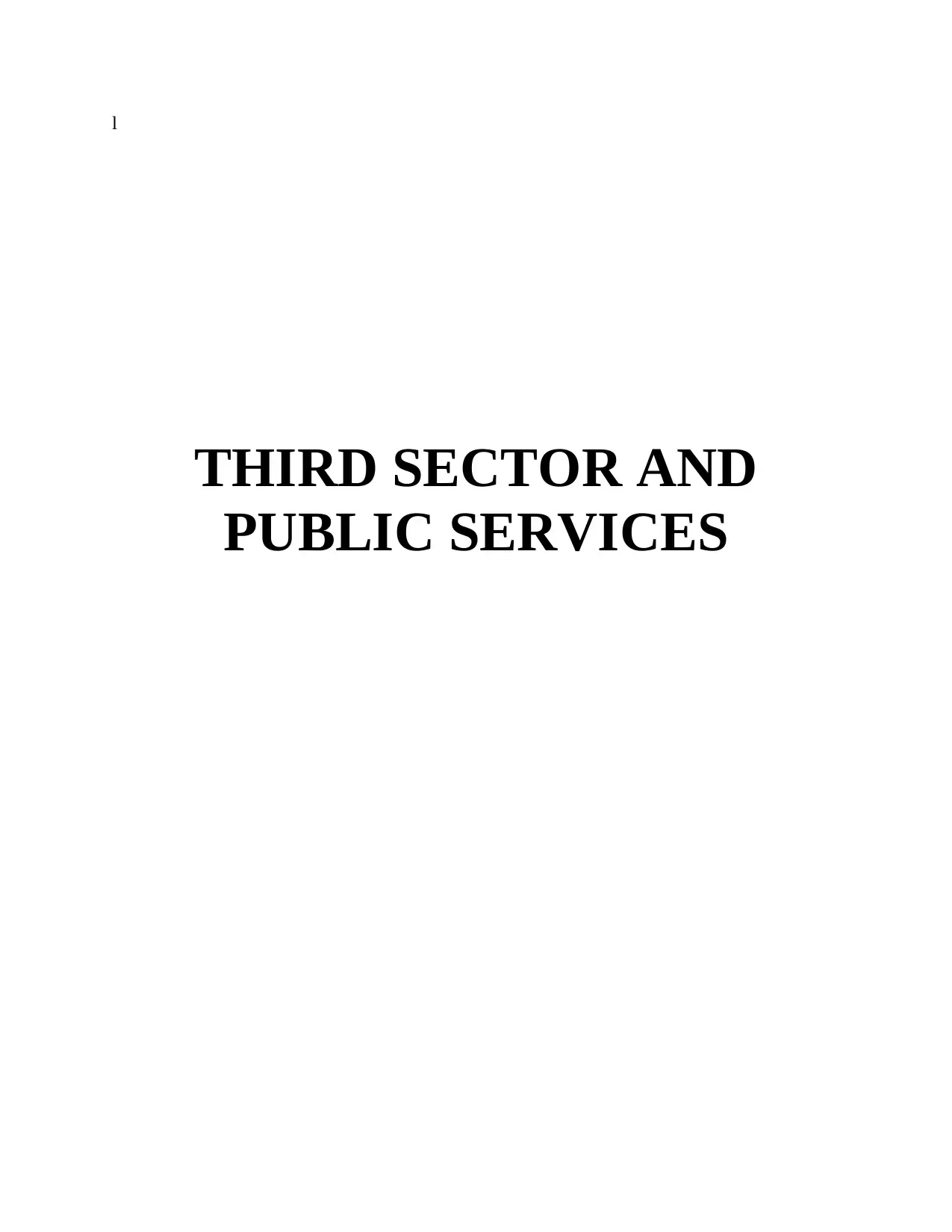
l
THIRD SECTOR AND
PUBLIC SERVICES
THIRD SECTOR AND
PUBLIC SERVICES
Paraphrase This Document
Need a fresh take? Get an instant paraphrase of this document with our AI Paraphraser

Table of Contents
INTRODUCTION...........................................................................................................................1
LO 1.................................................................................................................................................1
P1. Explanation of key events that have shaped the work of third sector organisations........1
LO 2.................................................................................................................................................2
P2. Identification of the types of work that third sector organisations are involved in..........2
LO 3.................................................................................................................................................3
P3. Outlining Types of public service delivered by third sector organisations......................3
P4. Defining examples of third sector organisations delivering public services....................4
LO 4.................................................................................................................................................5
P5. Outlining ways in which third sector organisations work in partnerships with public
services...................................................................................................................................5
P6. Explanation of benefits and barriers to using third sector organisations for public service
delivery...................................................................................................................................5
CONCLUSION................................................................................................................................6
REFERENCES................................................................................................................................8
INTRODUCTION...........................................................................................................................1
LO 1.................................................................................................................................................1
P1. Explanation of key events that have shaped the work of third sector organisations........1
LO 2.................................................................................................................................................2
P2. Identification of the types of work that third sector organisations are involved in..........2
LO 3.................................................................................................................................................3
P3. Outlining Types of public service delivered by third sector organisations......................3
P4. Defining examples of third sector organisations delivering public services....................4
LO 4.................................................................................................................................................5
P5. Outlining ways in which third sector organisations work in partnerships with public
services...................................................................................................................................5
P6. Explanation of benefits and barriers to using third sector organisations for public service
delivery...................................................................................................................................5
CONCLUSION................................................................................................................................6
REFERENCES................................................................................................................................8
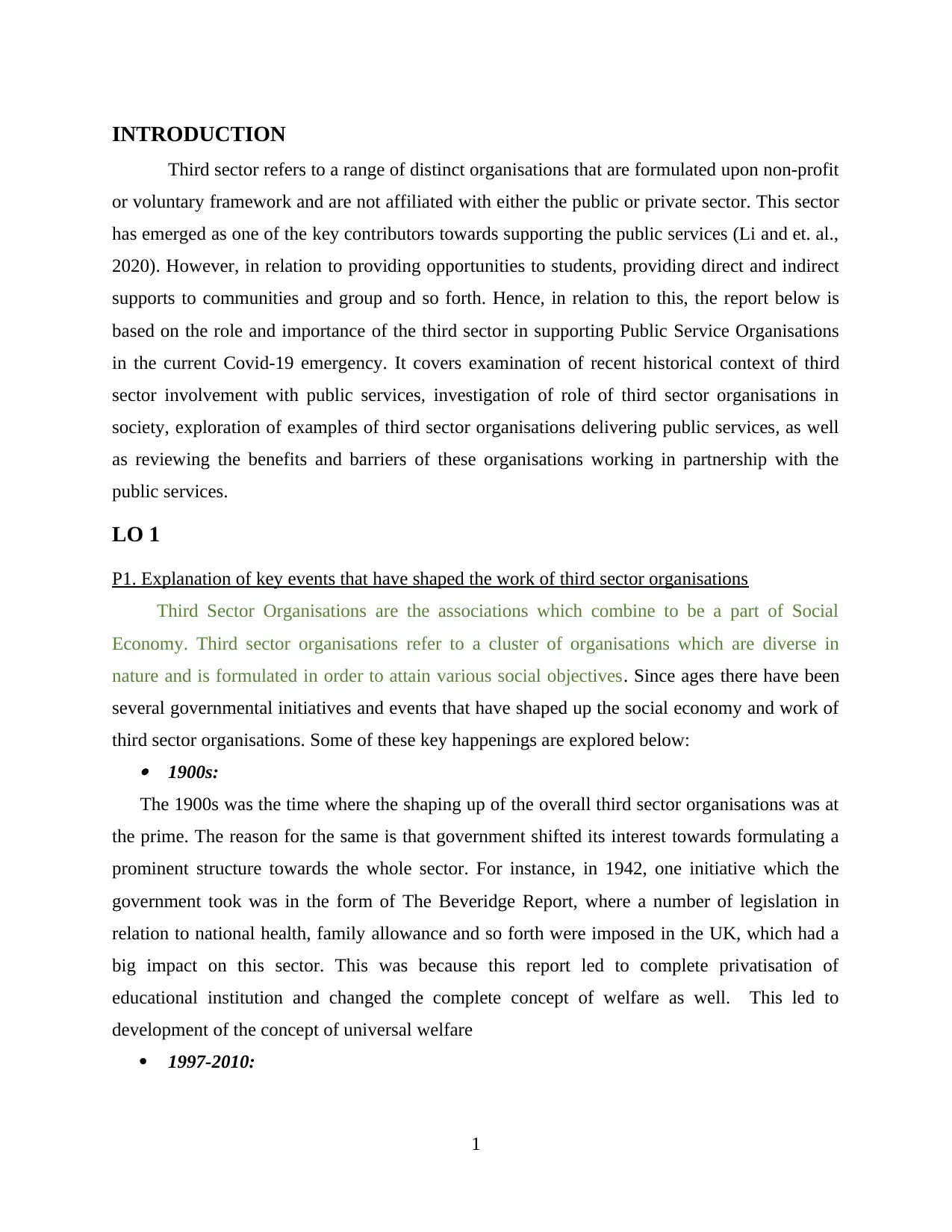
INTRODUCTION
Third sector refers to a range of distinct organisations that are formulated upon non-profit
or voluntary framework and are not affiliated with either the public or private sector. This sector
has emerged as one of the key contributors towards supporting the public services (Li and et. al.,
2020). However, in relation to providing opportunities to students, providing direct and indirect
supports to communities and group and so forth. Hence, in relation to this, the report below is
based on the role and importance of the third sector in supporting Public Service Organisations
in the current Covid-19 emergency. It covers examination of recent historical context of third
sector involvement with public services, investigation of role of third sector organisations in
society, exploration of examples of third sector organisations delivering public services, as well
as reviewing the benefits and barriers of these organisations working in partnership with the
public services.
LO 1
P1. Explanation of key events that have shaped the work of third sector organisations
Third Sector Organisations are the associations which combine to be a part of Social
Economy. Third sector organisations refer to a cluster of organisations which are diverse in
nature and is formulated in order to attain various social objectives. Since ages there have been
several governmental initiatives and events that have shaped up the social economy and work of
third sector organisations. Some of these key happenings are explored below: 1900s:
The 1900s was the time where the shaping up of the overall third sector organisations was at
the prime. The reason for the same is that government shifted its interest towards formulating a
prominent structure towards the whole sector. For instance, in 1942, one initiative which the
government took was in the form of The Beveridge Report, where a number of legislation in
relation to national health, family allowance and so forth were imposed in the UK, which had a
big impact on this sector. This was because this report led to complete privatisation of
educational institution and changed the complete concept of welfare as well. This led to
development of the concept of universal welfare
1997-2010:
1
Third sector refers to a range of distinct organisations that are formulated upon non-profit
or voluntary framework and are not affiliated with either the public or private sector. This sector
has emerged as one of the key contributors towards supporting the public services (Li and et. al.,
2020). However, in relation to providing opportunities to students, providing direct and indirect
supports to communities and group and so forth. Hence, in relation to this, the report below is
based on the role and importance of the third sector in supporting Public Service Organisations
in the current Covid-19 emergency. It covers examination of recent historical context of third
sector involvement with public services, investigation of role of third sector organisations in
society, exploration of examples of third sector organisations delivering public services, as well
as reviewing the benefits and barriers of these organisations working in partnership with the
public services.
LO 1
P1. Explanation of key events that have shaped the work of third sector organisations
Third Sector Organisations are the associations which combine to be a part of Social
Economy. Third sector organisations refer to a cluster of organisations which are diverse in
nature and is formulated in order to attain various social objectives. Since ages there have been
several governmental initiatives and events that have shaped up the social economy and work of
third sector organisations. Some of these key happenings are explored below: 1900s:
The 1900s was the time where the shaping up of the overall third sector organisations was at
the prime. The reason for the same is that government shifted its interest towards formulating a
prominent structure towards the whole sector. For instance, in 1942, one initiative which the
government took was in the form of The Beveridge Report, where a number of legislation in
relation to national health, family allowance and so forth were imposed in the UK, which had a
big impact on this sector. This was because this report led to complete privatisation of
educational institution and changed the complete concept of welfare as well. This led to
development of the concept of universal welfare
1997-2010:
1
⊘ This is a preview!⊘
Do you want full access?
Subscribe today to unlock all pages.

Trusted by 1+ million students worldwide
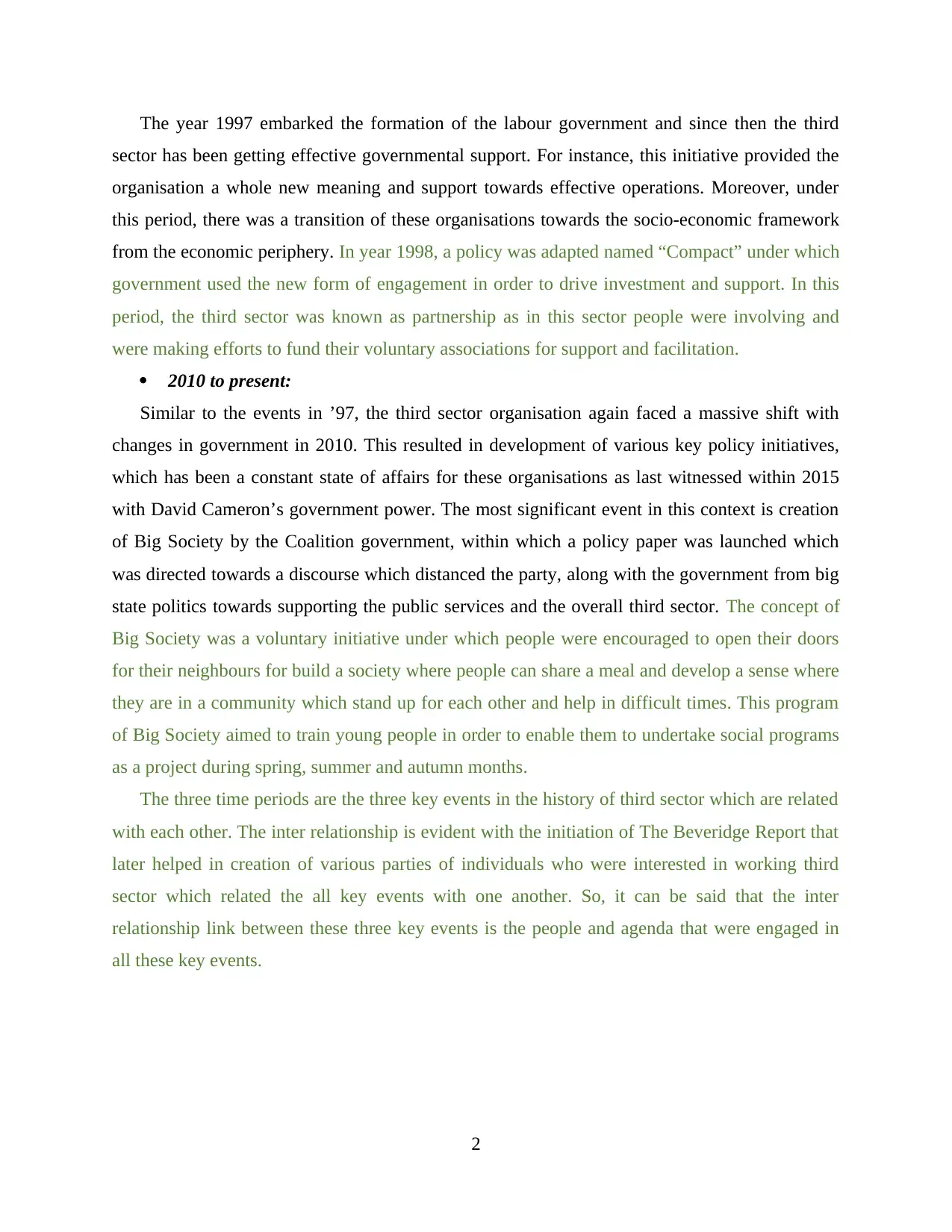
The year 1997 embarked the formation of the labour government and since then the third
sector has been getting effective governmental support. For instance, this initiative provided the
organisation a whole new meaning and support towards effective operations. Moreover, under
this period, there was a transition of these organisations towards the socio-economic framework
from the economic periphery. In year 1998, a policy was adapted named “Compact” under which
government used the new form of engagement in order to drive investment and support. In this
period, the third sector was known as partnership as in this sector people were involving and
were making efforts to fund their voluntary associations for support and facilitation.
2010 to present:
Similar to the events in ’97, the third sector organisation again faced a massive shift with
changes in government in 2010. This resulted in development of various key policy initiatives,
which has been a constant state of affairs for these organisations as last witnessed within 2015
with David Cameron’s government power. The most significant event in this context is creation
of Big Society by the Coalition government, within which a policy paper was launched which
was directed towards a discourse which distanced the party, along with the government from big
state politics towards supporting the public services and the overall third sector. The concept of
Big Society was a voluntary initiative under which people were encouraged to open their doors
for their neighbours for build a society where people can share a meal and develop a sense where
they are in a community which stand up for each other and help in difficult times. This program
of Big Society aimed to train young people in order to enable them to undertake social programs
as a project during spring, summer and autumn months.
The three time periods are the three key events in the history of third sector which are related
with each other. The inter relationship is evident with the initiation of The Beveridge Report that
later helped in creation of various parties of individuals who were interested in working third
sector which related the all key events with one another. So, it can be said that the inter
relationship link between these three key events is the people and agenda that were engaged in
all these key events.
2
sector has been getting effective governmental support. For instance, this initiative provided the
organisation a whole new meaning and support towards effective operations. Moreover, under
this period, there was a transition of these organisations towards the socio-economic framework
from the economic periphery. In year 1998, a policy was adapted named “Compact” under which
government used the new form of engagement in order to drive investment and support. In this
period, the third sector was known as partnership as in this sector people were involving and
were making efforts to fund their voluntary associations for support and facilitation.
2010 to present:
Similar to the events in ’97, the third sector organisation again faced a massive shift with
changes in government in 2010. This resulted in development of various key policy initiatives,
which has been a constant state of affairs for these organisations as last witnessed within 2015
with David Cameron’s government power. The most significant event in this context is creation
of Big Society by the Coalition government, within which a policy paper was launched which
was directed towards a discourse which distanced the party, along with the government from big
state politics towards supporting the public services and the overall third sector. The concept of
Big Society was a voluntary initiative under which people were encouraged to open their doors
for their neighbours for build a society where people can share a meal and develop a sense where
they are in a community which stand up for each other and help in difficult times. This program
of Big Society aimed to train young people in order to enable them to undertake social programs
as a project during spring, summer and autumn months.
The three time periods are the three key events in the history of third sector which are related
with each other. The inter relationship is evident with the initiation of The Beveridge Report that
later helped in creation of various parties of individuals who were interested in working third
sector which related the all key events with one another. So, it can be said that the inter
relationship link between these three key events is the people and agenda that were engaged in
all these key events.
2
Paraphrase This Document
Need a fresh take? Get an instant paraphrase of this document with our AI Paraphraser
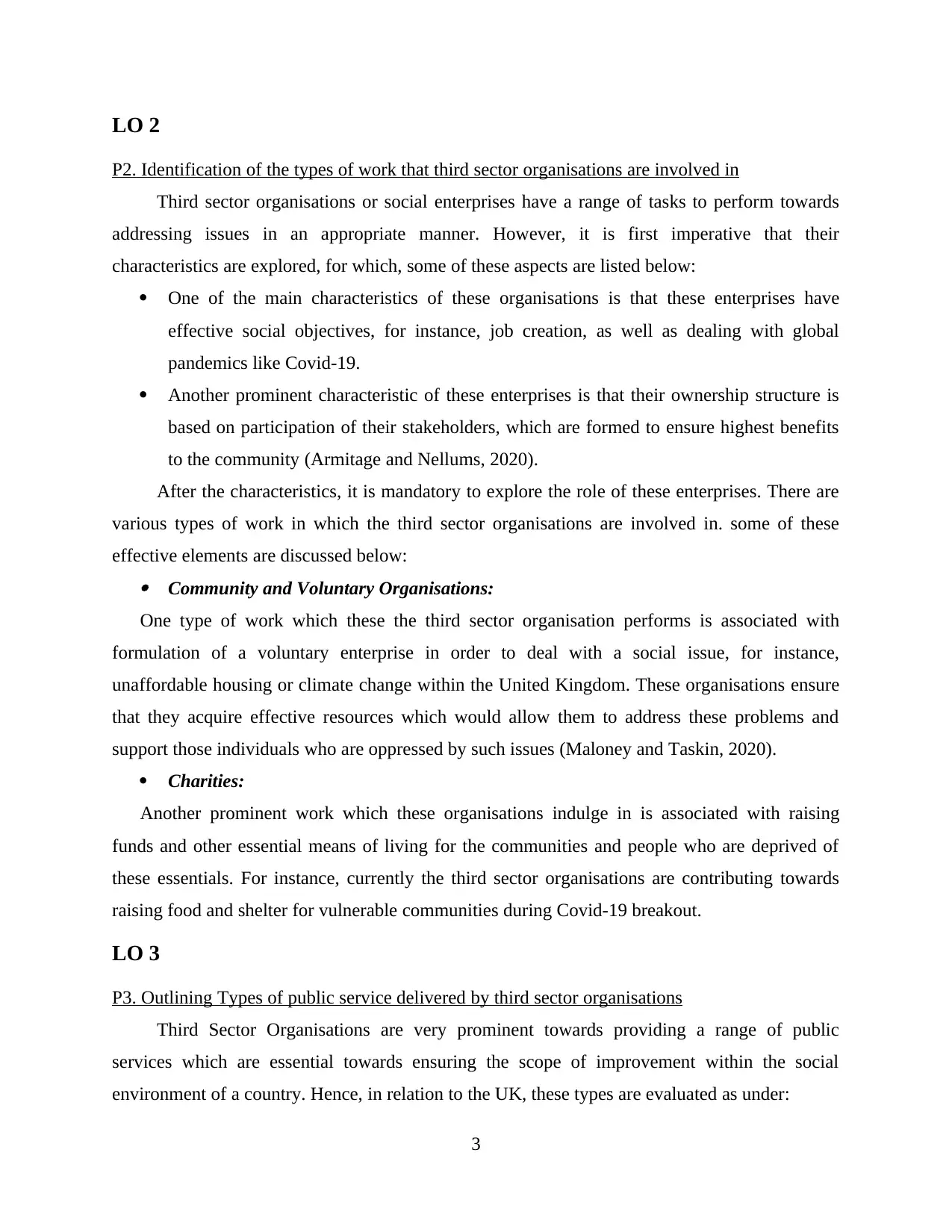
LO 2
P2. Identification of the types of work that third sector organisations are involved in
Third sector organisations or social enterprises have a range of tasks to perform towards
addressing issues in an appropriate manner. However, it is first imperative that their
characteristics are explored, for which, some of these aspects are listed below:
One of the main characteristics of these organisations is that these enterprises have
effective social objectives, for instance, job creation, as well as dealing with global
pandemics like Covid-19.
Another prominent characteristic of these enterprises is that their ownership structure is
based on participation of their stakeholders, which are formed to ensure highest benefits
to the community (Armitage and Nellums, 2020).
After the characteristics, it is mandatory to explore the role of these enterprises. There are
various types of work in which the third sector organisations are involved in. some of these
effective elements are discussed below: Community and Voluntary Organisations:
One type of work which these the third sector organisation performs is associated with
formulation of a voluntary enterprise in order to deal with a social issue, for instance,
unaffordable housing or climate change within the United Kingdom. These organisations ensure
that they acquire effective resources which would allow them to address these problems and
support those individuals who are oppressed by such issues (Maloney and Taskin, 2020).
Charities:
Another prominent work which these organisations indulge in is associated with raising
funds and other essential means of living for the communities and people who are deprived of
these essentials. For instance, currently the third sector organisations are contributing towards
raising food and shelter for vulnerable communities during Covid-19 breakout.
LO 3
P3. Outlining Types of public service delivered by third sector organisations
Third Sector Organisations are very prominent towards providing a range of public
services which are essential towards ensuring the scope of improvement within the social
environment of a country. Hence, in relation to the UK, these types are evaluated as under:
3
P2. Identification of the types of work that third sector organisations are involved in
Third sector organisations or social enterprises have a range of tasks to perform towards
addressing issues in an appropriate manner. However, it is first imperative that their
characteristics are explored, for which, some of these aspects are listed below:
One of the main characteristics of these organisations is that these enterprises have
effective social objectives, for instance, job creation, as well as dealing with global
pandemics like Covid-19.
Another prominent characteristic of these enterprises is that their ownership structure is
based on participation of their stakeholders, which are formed to ensure highest benefits
to the community (Armitage and Nellums, 2020).
After the characteristics, it is mandatory to explore the role of these enterprises. There are
various types of work in which the third sector organisations are involved in. some of these
effective elements are discussed below: Community and Voluntary Organisations:
One type of work which these the third sector organisation performs is associated with
formulation of a voluntary enterprise in order to deal with a social issue, for instance,
unaffordable housing or climate change within the United Kingdom. These organisations ensure
that they acquire effective resources which would allow them to address these problems and
support those individuals who are oppressed by such issues (Maloney and Taskin, 2020).
Charities:
Another prominent work which these organisations indulge in is associated with raising
funds and other essential means of living for the communities and people who are deprived of
these essentials. For instance, currently the third sector organisations are contributing towards
raising food and shelter for vulnerable communities during Covid-19 breakout.
LO 3
P3. Outlining Types of public service delivered by third sector organisations
Third Sector Organisations are very prominent towards providing a range of public
services which are essential towards ensuring the scope of improvement within the social
environment of a country. Hence, in relation to the UK, these types are evaluated as under:
3

Public Campaigning:
One of the main public service which these organisations engage themselves in is related to
carrying out public campaigns. Third Sector Organisations raise appropriate public awareness
within the UK about subjects that are within their interest. For instance, the Covid-19 outbreak,
its consequences and awareness about safeguarding procedures were appropriately and
effectively campaigned by several TSOs and ensured effective public awareness about how
lethal this virus is for the whole nation. Moreover, they also engaged towards campaigning about
the availability of necessary resources and help which the vulnerable communities could obtain
from the individuals.
Advocacy:
Another form of public service which the organisations engage in is related to bringing
policy changes in the current framework if they seem any sort of inconvenience to individuals
through that particular policy or amendment. This makes them the people’s advocate (Davis and
et. al., 2020).
Commissioning Research:
This public service is associated with investigating the issues which the communities and
people in general are facing, with effectively employing their own researchers. This allows them
towards ensuring effectiveness in dealing with the emerging issues. For instance, the public
sector organisations have been indulging towards researching and implementing the safeguarding
procedures for people to deal with Covid-19 pandemic and keep themselves and other secure
form the virus outbreak (Fernandes, 2020).
P4. Defining examples of third sector organisations delivering public services
Within the United Kingdom, there are various organisations that are providing public
services during a global emergency like Covid-19 by not only campaigning or researching the
safeguarding measures, but through also providing medical, social and accommodation services
to the people in need. Therefore, in regards to this, some of the prominent Third Sector
Organisations are listed below: Age UK:
This third sector organisation is a charity organisation of United Kingdom which operates to
help old age people and provide them assistance based on shelter and medical requirements.
For example: Age UK has 400 charity shops across the country which procure funds. This
4
One of the main public service which these organisations engage themselves in is related to
carrying out public campaigns. Third Sector Organisations raise appropriate public awareness
within the UK about subjects that are within their interest. For instance, the Covid-19 outbreak,
its consequences and awareness about safeguarding procedures were appropriately and
effectively campaigned by several TSOs and ensured effective public awareness about how
lethal this virus is for the whole nation. Moreover, they also engaged towards campaigning about
the availability of necessary resources and help which the vulnerable communities could obtain
from the individuals.
Advocacy:
Another form of public service which the organisations engage in is related to bringing
policy changes in the current framework if they seem any sort of inconvenience to individuals
through that particular policy or amendment. This makes them the people’s advocate (Davis and
et. al., 2020).
Commissioning Research:
This public service is associated with investigating the issues which the communities and
people in general are facing, with effectively employing their own researchers. This allows them
towards ensuring effectiveness in dealing with the emerging issues. For instance, the public
sector organisations have been indulging towards researching and implementing the safeguarding
procedures for people to deal with Covid-19 pandemic and keep themselves and other secure
form the virus outbreak (Fernandes, 2020).
P4. Defining examples of third sector organisations delivering public services
Within the United Kingdom, there are various organisations that are providing public
services during a global emergency like Covid-19 by not only campaigning or researching the
safeguarding measures, but through also providing medical, social and accommodation services
to the people in need. Therefore, in regards to this, some of the prominent Third Sector
Organisations are listed below: Age UK:
This third sector organisation is a charity organisation of United Kingdom which operates to
help old age people and provide them assistance based on shelter and medical requirements.
For example: Age UK has 400 charity shops across the country which procure funds. This
4
⊘ This is a preview!⊘
Do you want full access?
Subscribe today to unlock all pages.

Trusted by 1+ million students worldwide

association also has a confidential service advice line where volunteers and experts of this
organisation provides free advice regarding ageing and answer to all questions about ageing.
In this current scenario of COVID 19 pandemic, this organisation is helping ageing people
to provide them medical assistance and shelter. Oxfam:
It is yet another effective organisation working within the United Kingdom in its Third
Sector. There are several initiatives which the organisation is currently taking despite of access
restrictions to ensure that safety and security is facilitated in the country. For this, the firm has
formulated humanitarian aid delivery system, which is directed towards poor communities and
households and provides them with effective and essential assistance which could protect them
from catching any sort of infection virus outbreak effectively (Bartik and et. al., 2020). For
example: this association is distributing food packages to poor and poverty driven people of UK
in this current scenario of pandemic so that they can ensure immunity of people.
Barnardo’s:
This organisation prominently works towards welfare of children, along with other social
services. During the Coronavirus outbreak, the organisation has set up and is distributing
toolkits for the MPs to ensure prominent support give to the children, as well as their families
(Barnardo’s Covid-19 Toolkit, 2020).
LO 4
P5. Outlining ways in which third sector organisations work in partnerships with public services
It is quite crucial for the third sector organisation to work in partnership with public
services in order to ensure effective facilitation of public welfare within the country, which is a
mandatory step towards dealing with a range of public issues in a better manner (McKibbin and
Fernando, 2020). Therefore, below are several ways in which this partnership could be
formulated and strengthened effectively in the near future: Transfer of Properties:
One of the most prominent ways through which the partnership between the third sector
organisations and public services could enhance is through provision transfer of properties to the
TSOs. With access to public sector properties and assets, the resource constraint over the third
5
organisation provides free advice regarding ageing and answer to all questions about ageing.
In this current scenario of COVID 19 pandemic, this organisation is helping ageing people
to provide them medical assistance and shelter. Oxfam:
It is yet another effective organisation working within the United Kingdom in its Third
Sector. There are several initiatives which the organisation is currently taking despite of access
restrictions to ensure that safety and security is facilitated in the country. For this, the firm has
formulated humanitarian aid delivery system, which is directed towards poor communities and
households and provides them with effective and essential assistance which could protect them
from catching any sort of infection virus outbreak effectively (Bartik and et. al., 2020). For
example: this association is distributing food packages to poor and poverty driven people of UK
in this current scenario of pandemic so that they can ensure immunity of people.
Barnardo’s:
This organisation prominently works towards welfare of children, along with other social
services. During the Coronavirus outbreak, the organisation has set up and is distributing
toolkits for the MPs to ensure prominent support give to the children, as well as their families
(Barnardo’s Covid-19 Toolkit, 2020).
LO 4
P5. Outlining ways in which third sector organisations work in partnerships with public services
It is quite crucial for the third sector organisation to work in partnership with public
services in order to ensure effective facilitation of public welfare within the country, which is a
mandatory step towards dealing with a range of public issues in a better manner (McKibbin and
Fernando, 2020). Therefore, below are several ways in which this partnership could be
formulated and strengthened effectively in the near future: Transfer of Properties:
One of the most prominent ways through which the partnership between the third sector
organisations and public services could enhance is through provision transfer of properties to the
TSOs. With access to public sector properties and assets, the resource constraint over the third
5
Paraphrase This Document
Need a fresh take? Get an instant paraphrase of this document with our AI Paraphraser
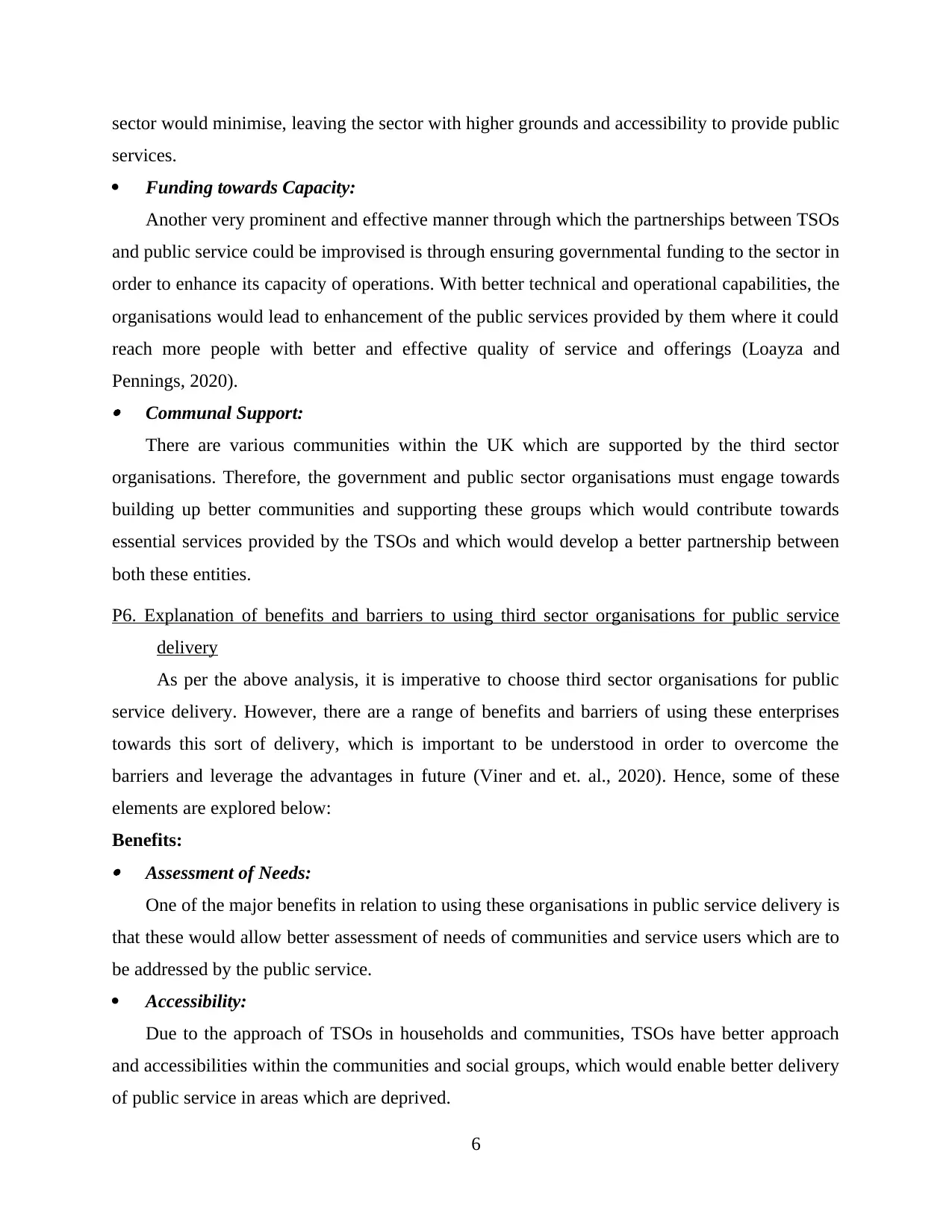
sector would minimise, leaving the sector with higher grounds and accessibility to provide public
services.
Funding towards Capacity:
Another very prominent and effective manner through which the partnerships between TSOs
and public service could be improvised is through ensuring governmental funding to the sector in
order to enhance its capacity of operations. With better technical and operational capabilities, the
organisations would lead to enhancement of the public services provided by them where it could
reach more people with better and effective quality of service and offerings (Loayza and
Pennings, 2020). Communal Support:
There are various communities within the UK which are supported by the third sector
organisations. Therefore, the government and public sector organisations must engage towards
building up better communities and supporting these groups which would contribute towards
essential services provided by the TSOs and which would develop a better partnership between
both these entities.
P6. Explanation of benefits and barriers to using third sector organisations for public service
delivery
As per the above analysis, it is imperative to choose third sector organisations for public
service delivery. However, there are a range of benefits and barriers of using these enterprises
towards this sort of delivery, which is important to be understood in order to overcome the
barriers and leverage the advantages in future (Viner and et. al., 2020). Hence, some of these
elements are explored below:
Benefits: Assessment of Needs:
One of the major benefits in relation to using these organisations in public service delivery is
that these would allow better assessment of needs of communities and service users which are to
be addressed by the public service.
Accessibility:
Due to the approach of TSOs in households and communities, TSOs have better approach
and accessibilities within the communities and social groups, which would enable better delivery
of public service in areas which are deprived.
6
services.
Funding towards Capacity:
Another very prominent and effective manner through which the partnerships between TSOs
and public service could be improvised is through ensuring governmental funding to the sector in
order to enhance its capacity of operations. With better technical and operational capabilities, the
organisations would lead to enhancement of the public services provided by them where it could
reach more people with better and effective quality of service and offerings (Loayza and
Pennings, 2020). Communal Support:
There are various communities within the UK which are supported by the third sector
organisations. Therefore, the government and public sector organisations must engage towards
building up better communities and supporting these groups which would contribute towards
essential services provided by the TSOs and which would develop a better partnership between
both these entities.
P6. Explanation of benefits and barriers to using third sector organisations for public service
delivery
As per the above analysis, it is imperative to choose third sector organisations for public
service delivery. However, there are a range of benefits and barriers of using these enterprises
towards this sort of delivery, which is important to be understood in order to overcome the
barriers and leverage the advantages in future (Viner and et. al., 2020). Hence, some of these
elements are explored below:
Benefits: Assessment of Needs:
One of the major benefits in relation to using these organisations in public service delivery is
that these would allow better assessment of needs of communities and service users which are to
be addressed by the public service.
Accessibility:
Due to the approach of TSOs in households and communities, TSOs have better approach
and accessibilities within the communities and social groups, which would enable better delivery
of public service in areas which are deprived.
6
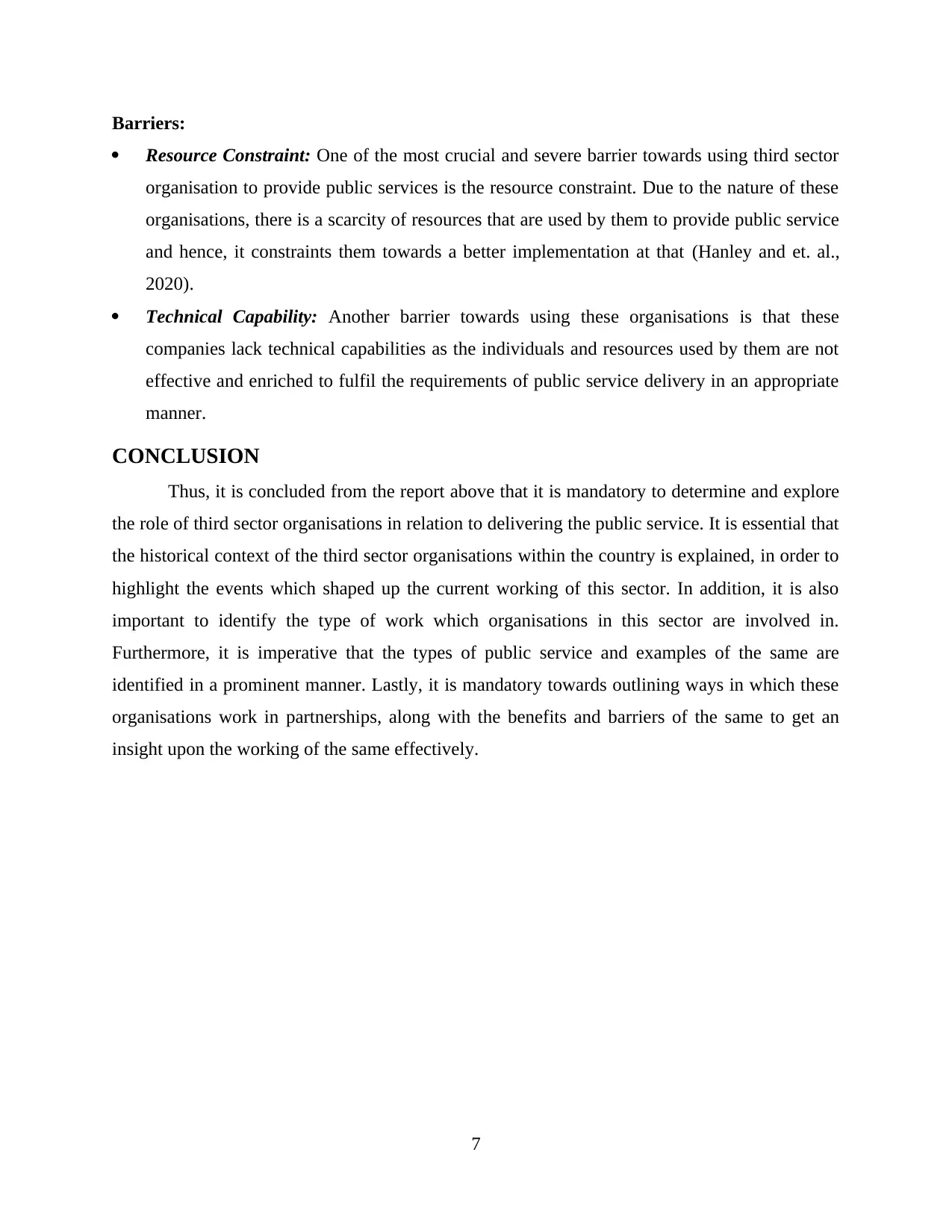
Barriers:
Resource Constraint: One of the most crucial and severe barrier towards using third sector
organisation to provide public services is the resource constraint. Due to the nature of these
organisations, there is a scarcity of resources that are used by them to provide public service
and hence, it constraints them towards a better implementation at that (Hanley and et. al.,
2020).
Technical Capability: Another barrier towards using these organisations is that these
companies lack technical capabilities as the individuals and resources used by them are not
effective and enriched to fulfil the requirements of public service delivery in an appropriate
manner.
CONCLUSION
Thus, it is concluded from the report above that it is mandatory to determine and explore
the role of third sector organisations in relation to delivering the public service. It is essential that
the historical context of the third sector organisations within the country is explained, in order to
highlight the events which shaped up the current working of this sector. In addition, it is also
important to identify the type of work which organisations in this sector are involved in.
Furthermore, it is imperative that the types of public service and examples of the same are
identified in a prominent manner. Lastly, it is mandatory towards outlining ways in which these
organisations work in partnerships, along with the benefits and barriers of the same to get an
insight upon the working of the same effectively.
7
Resource Constraint: One of the most crucial and severe barrier towards using third sector
organisation to provide public services is the resource constraint. Due to the nature of these
organisations, there is a scarcity of resources that are used by them to provide public service
and hence, it constraints them towards a better implementation at that (Hanley and et. al.,
2020).
Technical Capability: Another barrier towards using these organisations is that these
companies lack technical capabilities as the individuals and resources used by them are not
effective and enriched to fulfil the requirements of public service delivery in an appropriate
manner.
CONCLUSION
Thus, it is concluded from the report above that it is mandatory to determine and explore
the role of third sector organisations in relation to delivering the public service. It is essential that
the historical context of the third sector organisations within the country is explained, in order to
highlight the events which shaped up the current working of this sector. In addition, it is also
important to identify the type of work which organisations in this sector are involved in.
Furthermore, it is imperative that the types of public service and examples of the same are
identified in a prominent manner. Lastly, it is mandatory towards outlining ways in which these
organisations work in partnerships, along with the benefits and barriers of the same to get an
insight upon the working of the same effectively.
7
⊘ This is a preview!⊘
Do you want full access?
Subscribe today to unlock all pages.

Trusted by 1+ million students worldwide
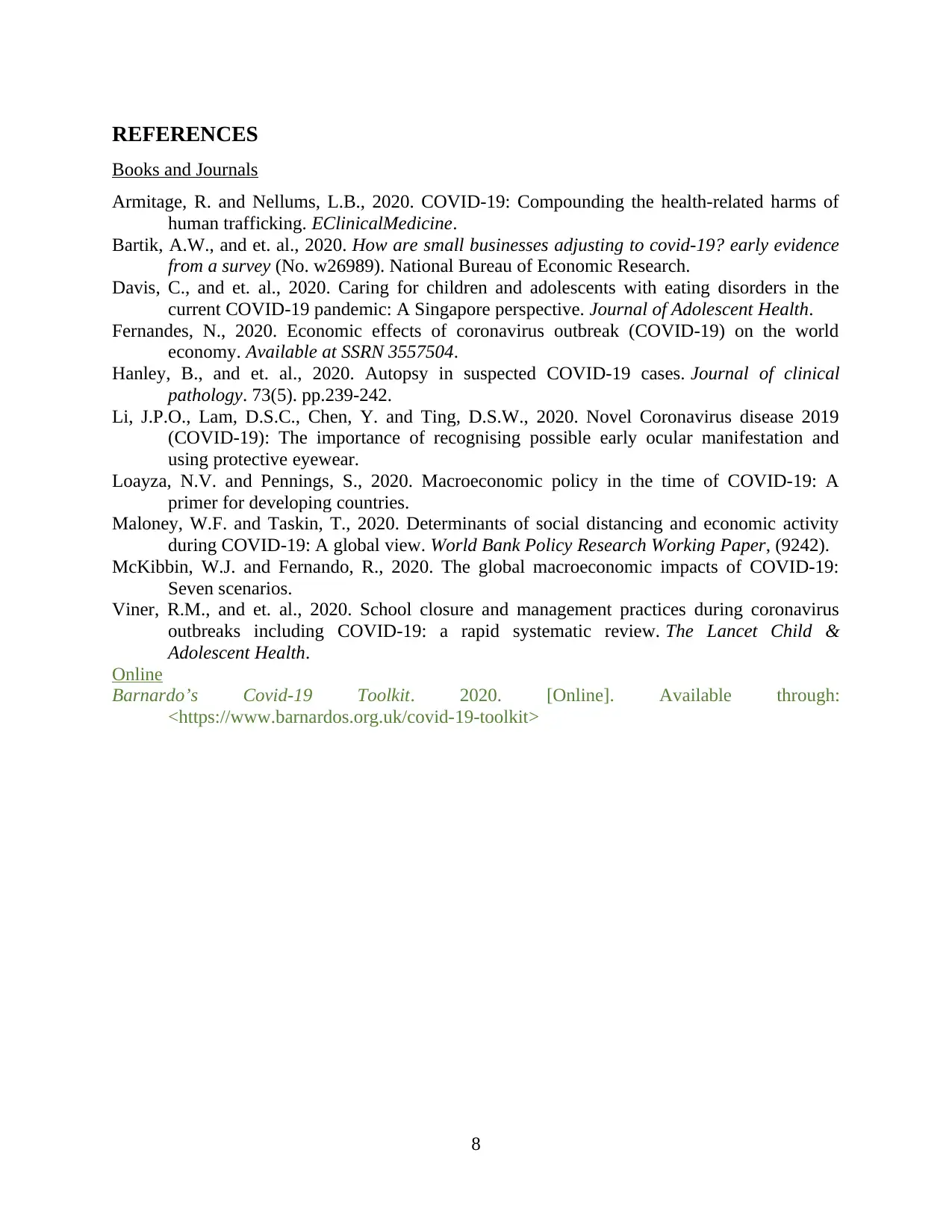
REFERENCES
Books and Journals
Armitage, R. and Nellums, L.B., 2020. COVID-19: Compounding the health-related harms of
human trafficking. EClinicalMedicine.
Bartik, A.W., and et. al., 2020. How are small businesses adjusting to covid-19? early evidence
from a survey (No. w26989). National Bureau of Economic Research.
Davis, C., and et. al., 2020. Caring for children and adolescents with eating disorders in the
current COVID-19 pandemic: A Singapore perspective. Journal of Adolescent Health.
Fernandes, N., 2020. Economic effects of coronavirus outbreak (COVID-19) on the world
economy. Available at SSRN 3557504.
Hanley, B., and et. al., 2020. Autopsy in suspected COVID-19 cases. Journal of clinical
pathology. 73(5). pp.239-242.
Li, J.P.O., Lam, D.S.C., Chen, Y. and Ting, D.S.W., 2020. Novel Coronavirus disease 2019
(COVID-19): The importance of recognising possible early ocular manifestation and
using protective eyewear.
Loayza, N.V. and Pennings, S., 2020. Macroeconomic policy in the time of COVID-19: A
primer for developing countries.
Maloney, W.F. and Taskin, T., 2020. Determinants of social distancing and economic activity
during COVID-19: A global view. World Bank Policy Research Working Paper, (9242).
McKibbin, W.J. and Fernando, R., 2020. The global macroeconomic impacts of COVID-19:
Seven scenarios.
Viner, R.M., and et. al., 2020. School closure and management practices during coronavirus
outbreaks including COVID-19: a rapid systematic review. The Lancet Child &
Adolescent Health.
Online
Barnardo’s Covid-19 Toolkit. 2020. [Online]. Available through:
<https://www.barnardos.org.uk/covid-19-toolkit>
8
Books and Journals
Armitage, R. and Nellums, L.B., 2020. COVID-19: Compounding the health-related harms of
human trafficking. EClinicalMedicine.
Bartik, A.W., and et. al., 2020. How are small businesses adjusting to covid-19? early evidence
from a survey (No. w26989). National Bureau of Economic Research.
Davis, C., and et. al., 2020. Caring for children and adolescents with eating disorders in the
current COVID-19 pandemic: A Singapore perspective. Journal of Adolescent Health.
Fernandes, N., 2020. Economic effects of coronavirus outbreak (COVID-19) on the world
economy. Available at SSRN 3557504.
Hanley, B., and et. al., 2020. Autopsy in suspected COVID-19 cases. Journal of clinical
pathology. 73(5). pp.239-242.
Li, J.P.O., Lam, D.S.C., Chen, Y. and Ting, D.S.W., 2020. Novel Coronavirus disease 2019
(COVID-19): The importance of recognising possible early ocular manifestation and
using protective eyewear.
Loayza, N.V. and Pennings, S., 2020. Macroeconomic policy in the time of COVID-19: A
primer for developing countries.
Maloney, W.F. and Taskin, T., 2020. Determinants of social distancing and economic activity
during COVID-19: A global view. World Bank Policy Research Working Paper, (9242).
McKibbin, W.J. and Fernando, R., 2020. The global macroeconomic impacts of COVID-19:
Seven scenarios.
Viner, R.M., and et. al., 2020. School closure and management practices during coronavirus
outbreaks including COVID-19: a rapid systematic review. The Lancet Child &
Adolescent Health.
Online
Barnardo’s Covid-19 Toolkit. 2020. [Online]. Available through:
<https://www.barnardos.org.uk/covid-19-toolkit>
8
1 out of 10
Related Documents
Your All-in-One AI-Powered Toolkit for Academic Success.
+13062052269
info@desklib.com
Available 24*7 on WhatsApp / Email
![[object Object]](/_next/static/media/star-bottom.7253800d.svg)
Unlock your academic potential
Copyright © 2020–2025 A2Z Services. All Rights Reserved. Developed and managed by ZUCOL.




